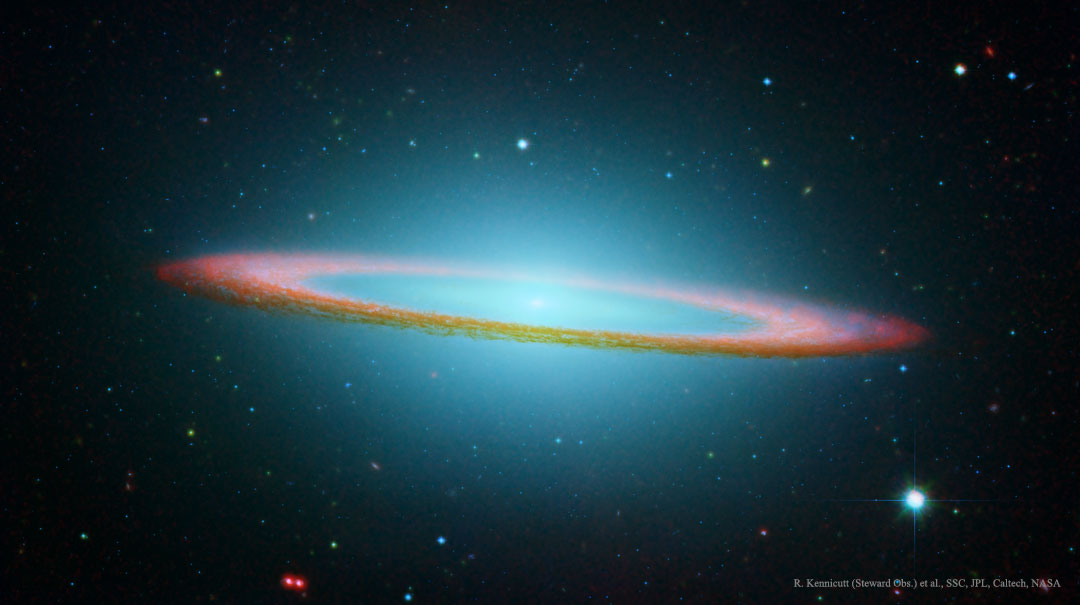|
|
NGC 4676: When Mice Collide
These two mighty galaxies are pulling each other apart. Known as the “Mice” because they have such long tails, each spiral galaxy has likely already passed through the other. The long tails are created by the relative difference between gravitational pulls on the near and far parts of each galaxy.
Because the distances are so large, the cosmic interaction takes place in slow motion — over hundreds of millions of years. NGC 4676 lies about 300 million light-years away toward the constellation of Bernice’s Hair (Coma Berenices) and are likely members of the Coma Cluster of Galaxies.
The bellow picture was taken with the Hubble Space Telescope’s Advanced Camera for Surveys in 2002. These galactic mice will probably collide again and again over the next billion years until they coalesce to form a single galaxy.
Image Credit: ACS Science & Engineering Team, Hubble Space Telescope, NASA
Image & info via APOD

The Sombrero Galaxy in Infrared
This floating ring is the size of a galaxy. In fact, it is a galaxy — or at least part of one: the photogenic Sombrero Galaxy, one of the largest galaxies in the nearby Virgo Cluster of Galaxies. The dark band of dust that obscures the mid-section of the Sombrero Galaxy in optical light actually glows brightly in infrared light.
This image, digitally sharpened, shows the infrared glow, recently recorded by the orbiting Spitzer Space Telescope, superposed in false-color on an existing image taken by NASA’s Hubble Space Telescope in optical light. The Sombrero Galaxy, also known as M104, spans about 50,000 light years across and lies 28 million light years away. M104 can be seen with a small telescope in the direction of the constellation Virgo.
Image & info via APOD
http://ift.tt/lsP8Th

Well done NASA. Over 8000 photos of the Moon missions uploaded to the internet.
From Apollo 7 to 17, including the ill-fated Apollo 13.
 |
NASA Will Announce A Major Mars Discovery On Monday
NASA is preparing to reveal a “major science finding” regarding Mars on Monday, with the agency planning a special news conference to announce the findings. The event will take place at 11.30 a.m. EDT (4.30 p.m. BST) on Monday, and you will be able to watch it live on NASA TV, which we have handily embedded below. Reporters will be onsite and asking questions by phone, while the public can get involved via #AskNASA. |
Have you still not got your boarding pass yet? What the fuck are you waiting for people?
NASA originally shared:
Join the nearly 300,000 people who have signed up to send their name to Mars on our upcoming InSight mission.
Send Your Name to Mars on NASA's Next Red Planet Mission
Mars enthusiasts around the world can participate in NASA’s journey to Mars by adding their names to a silicon microchip headed to the Red Planet aboard NASA's InSight Mars lander, scheduled to launch next year.
Very interesting article.
 |
Astronomers estimate 100 billion habitable Earth-like planets in the Milky Way, 50 sextillion in the universe | ExtremeTech
Astronomers at the University of Auckland claim that there are actually around 100 billion habitable, Earth-like planets in the Milky Way. There are roughly 500 billion galaxies in the universe, meaning there is somewhere in the region of 50,000,000,000,000,000,000,000 habitable planets. I’ll leave you to do the math on whether one of those 50 sextillion planets has the right conditions for nurturing life or not. |
At the Edge of NGC 2174
This fantastic skyscape lies near the edge of NGC 2174 a star forming region about 6,400 light-years away in the nebula-rich constellation of Orion. It follows mountainous clouds of gas and dust carved by winds and radiation from the region’s newborn stars, now found scattered in open star clusters embedded around the center of NGC 2174, off the top of the frame. Though star formation continues within these dusty cosmic clouds they will likely be dispersed by the energetic newborn stars within a few million years. Recorded at infrared wavelengths by the Hubble Space Telescope, the interstellar scene spans about 6 light-years. The image celebrates the upcoming 24th anniversary of Hubble’s launch onboard the space shuttle orbiter Discovery on April 24, 1990.
Very Cool 😁
Japanese Astronaut Koichi Wakata shared this image from the International Space Station on Twitter this Saturday morning saying “the sun does not set on low earth orbit for another few days as the ISS is tracking parallel to the terminator.”
The expansive International Space Station is a working laboratory orbiting 260 miles above the Earth, traveling at 17,500 mph, and is home to an international crew. It is the most complex scientific and technological endeavor ever undertaken. As a research outpost, the station is a test bed for future technologies and a research laboratory for new, advanced industrial materials, communications technology, medical research and much more.
Image credit: NASA/JAXA/Koichi Wakata
|
|












